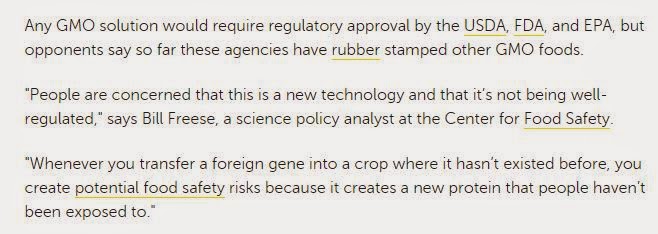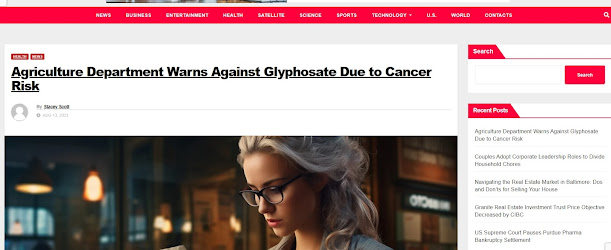The Citrus Crisis and False Balance
I'm so grateful to any author that takes the time to write about citrus greening disease and its potential solutions. When I saw the posting in Fast Company by Satta Sarmah, I was happy that someone might be providing a additional resources on the disease and its solutions.
When you read the article Does orange juice have to genetically modify or die? it does a good job describing some of the proposed solutions, some of which will involve the addition of transgenes. They mention Dr. Eric Mirkov's (Texas A&M) installation of a spinach gene and Dr. Jude Grosser's (Univ Florida) efforts with other transgenes. While many solutions have been attempted, a subset of them show strong potential to help solve the problem. To this point it is a factual summary of what science has done.
Then Sarmah makes the classic journalist mistake-- striving for balance. If scientists propose solutions, there must be some other opinion of equal importance, right?
The article then goes on to talk about deregulation. Do you spot why the following statements are inconsistent with allowable content in a scientific article?
The first line is correct in that it would likely require regulatory approval by those federal agencies. But why does what "opponents say" matter? Rubber stamp? The process takes forever and costs millions of dollars for the required testing and evaluation. Watch for this later!
Then to introduce what Bill Freese thinks further just obfuscates the issue. Freese works for the Center for Food Safety, an activist organization that continually fights applications of biotechnology. Freese can accurately state that consumers are concerned about regulation-- because he has dedicated his life to misinforming consumers about the regulation and generating fear about ag biotech.
The next line is the same old risk manufacturing tactic employed by anti-GM activists. Again, how the addition of a gene product, that people consume every day, poses no more risk than conventional breeding. Plus, this is not a product "people haven't been exposed to." They consume Mirkov's solution in every bite of spinach.
The article continues:
Wow! "Could take about 30 years"-- that's some rubber stamp. The fact is that these trees have been developed and have been tested, and it is simply a question of making 60 million of them after deregulation. That means we need to get them deregulated fast!
Freese then goes into a false balance of his own, stating alternatives that have been considered, are still being investigated, but cannot be practically deployed. If his solutions worked, they would have been adopted a decade ago and the industry would not be in collapse. Solutions that show some promise (like heat treatments and nutrition) can't be used easily on 60 million trees and still allow farmers to stay in business.
Freese then talks about the $135 million dollar rubber stamp. How Sarmah can write this and "rubber stamp" in the same article is beyond me.
Freese also talks about how the "majority (of disease resistant traits) have failed". Funny, because it does not matter what the majority do, if one works. There is evidence in the literature, again and again, that plants can be generated with transgenes to help resist disease. Freese's Center for Food Safety will stand in the way of the development of any biotech crop. The fact of the matter is that Mirkov and Grosser's solutions do work-- we know that already, that's why these scientists are dedicating their time to their development.
While I applaud Sarmah for bringing attention to this problem, I'm again disappointed that the efforts of public scientists trying to solve a massive problem affecting many family farms, are upstaged by the empty words of an activist sworn to end any application of biotechnology. It is classic false balance, teaching the controversy, non-experts with agendas given the same space as those dedicating their lives to scientifically solving critical issues in agriculture.
And Freese knows that if a biotech solution saves the citrus industry, he's out of a job. He needs to keep building a non-existent boogeyman in order to keep the public skeptical of biotechnology, fighting it every step of the way.
Saving citrus will be a challenge that will require the best tools of nutrition, pest management, genetics and biotechnology. There is no silver bullet. We need all tools to be used to continue sustainable production of this nutritious fruit.
When you read the article Does orange juice have to genetically modify or die? it does a good job describing some of the proposed solutions, some of which will involve the addition of transgenes. They mention Dr. Eric Mirkov's (Texas A&M) installation of a spinach gene and Dr. Jude Grosser's (Univ Florida) efforts with other transgenes. While many solutions have been attempted, a subset of them show strong potential to help solve the problem. To this point it is a factual summary of what science has done.
Then Sarmah makes the classic journalist mistake-- striving for balance. If scientists propose solutions, there must be some other opinion of equal importance, right?
The article then goes on to talk about deregulation. Do you spot why the following statements are inconsistent with allowable content in a scientific article?
The first line is correct in that it would likely require regulatory approval by those federal agencies. But why does what "opponents say" matter? Rubber stamp? The process takes forever and costs millions of dollars for the required testing and evaluation. Watch for this later!
Then to introduce what Bill Freese thinks further just obfuscates the issue. Freese works for the Center for Food Safety, an activist organization that continually fights applications of biotechnology. Freese can accurately state that consumers are concerned about regulation-- because he has dedicated his life to misinforming consumers about the regulation and generating fear about ag biotech.
The next line is the same old risk manufacturing tactic employed by anti-GM activists. Again, how the addition of a gene product, that people consume every day, poses no more risk than conventional breeding. Plus, this is not a product "people haven't been exposed to." They consume Mirkov's solution in every bite of spinach.
The article continues:
Wow! "Could take about 30 years"-- that's some rubber stamp. The fact is that these trees have been developed and have been tested, and it is simply a question of making 60 million of them after deregulation. That means we need to get them deregulated fast!
Freese then goes into a false balance of his own, stating alternatives that have been considered, are still being investigated, but cannot be practically deployed. If his solutions worked, they would have been adopted a decade ago and the industry would not be in collapse. Solutions that show some promise (like heat treatments and nutrition) can't be used easily on 60 million trees and still allow farmers to stay in business.
Freese then talks about the $135 million dollar rubber stamp. How Sarmah can write this and "rubber stamp" in the same article is beyond me.
Freese also talks about how the "majority (of disease resistant traits) have failed". Funny, because it does not matter what the majority do, if one works. There is evidence in the literature, again and again, that plants can be generated with transgenes to help resist disease. Freese's Center for Food Safety will stand in the way of the development of any biotech crop. The fact of the matter is that Mirkov and Grosser's solutions do work-- we know that already, that's why these scientists are dedicating their time to their development.
While I applaud Sarmah for bringing attention to this problem, I'm again disappointed that the efforts of public scientists trying to solve a massive problem affecting many family farms, are upstaged by the empty words of an activist sworn to end any application of biotechnology. It is classic false balance, teaching the controversy, non-experts with agendas given the same space as those dedicating their lives to scientifically solving critical issues in agriculture.
And Freese knows that if a biotech solution saves the citrus industry, he's out of a job. He needs to keep building a non-existent boogeyman in order to keep the public skeptical of biotechnology, fighting it every step of the way.
Saving citrus will be a challenge that will require the best tools of nutrition, pest management, genetics and biotechnology. There is no silver bullet. We need all tools to be used to continue sustainable production of this nutritious fruit.



